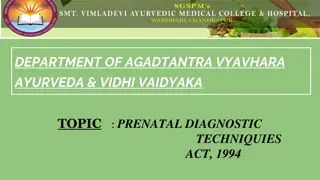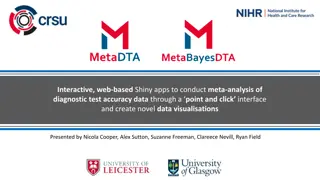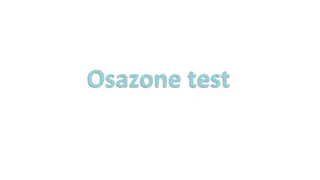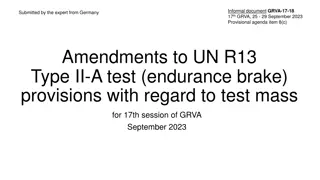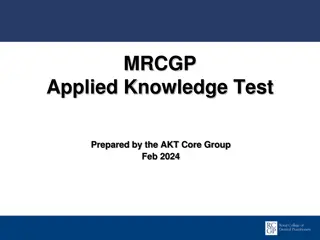Understanding Diagnostic Test Evaluation and Performance
Explore the intricacies of evaluating diagnostic tests, including precision, sensitivity, specificity, and factors influencing test performance. Learn about the purpose of diagnostic tests, examples across various fields, and the types of studies used to assess them.
Download Presentation
Please find below an Image/Link to download the presentation.
The content on the website is provided AS IS for your information and personal use only. It may not be sold, licensed, or shared on other websites without obtaining consent from the author. Download presentation by click this link. If you encounter any issues during the download, it is possible that the publisher has removed the file from their server.
Uploaded on Apr 05, 2024 | 9 Views
Presentation Transcript
Study Design and Analysis: Diagnostic Studies 2023 Mary Dunbar MD MSc MSc FRCPC Assistant Professor of Pediatrics, University of Calgary Pediatric Neurologist, Alberta Children s Hospital Slide Credit: many slides taken from Dr. S. Greenaway s lecture from two years ago
Objectives Understand the issues in the evaluation of a diagnostic test Appreciate components of evaluating test performance precision and accuracy sensitivity and specificity likelihood ratio positive and negative predictive values receiver operating characteristic (ROC) curves additional factors: cost, availability, acceptability, utility
Examples of Diagnostic Tests Biochemical electrolytes, urea, creatinine Imaging CXR, MRI Genetic karyotype, array, WES Microbiological blood culture Physiological PFTs, exercise test, GTT Clinical Lever sign to diagnose ACL tear Patient-reported outcome measures questionnaire of symptoms to diagnose IBD
Purpose of diagnostic tests Diagnose a disease or condition TSH echocardiogram Exclude a disease or condition HbA1C Troponin Estimate prognosis LDL cholesterol BRCA1 mutation Inform treatment decisions PSA karyotype
Factors Affecting Diagnostic Test Performance Prevalence of the disease in the population Spectrum of the disease Often dependent on other factors part of diagnostic pathway test results may not be independent often depend on prior knowledge Gold standard established test which confirms the diagnosis
Types of Studies to Evaluate a Diagnostic Test Precision (reproducibility) intra-observer (amount of variation for a single observer) inter-observer (variation between 2 or more observers) Accuracy cohort case-control Costs, Risks and Acceptability prospective retrospective Improvement of clinical outcome RCT case-control
Precision Reproducibility or repeatability Agreement between repeated measures Intra-observer variability agreement with your previous interpretation Inter-observer variability agreement between observers
Accuracy Closeness of measurements to a specific value To what extent does the test give the right answer Requires a gold standard (definitive assessment) Measures of accuracy Sensitivity and specificity positive and negative predictive values receiver operating characteristic (ROC) curve likelihood ratio
https://www.google.com/url?sa=i&url=https%3A%2F%2Fwp.stolaf. edu%2Fit%2Fgis-precision-accuracy%2F&psig=AOvVaw1n_ExUOnO- v4UWNFEReZIr&ust=1667082302398000&source=images&cd=vfe& ved=0CAwQjRxqFwoTCJi63NP7g_sCFQAAAAAdAAAAABAX
Sensitivity & Specificity Sensitivity proportion of positive tests out of total disease Given you have the disease, proportion that have a positive test (T+|D+) correctly identified positives true-positive rate The probability that a person with the disease is classified correctly by the test Specificity proportion of negative tests out of total non-diseased Given you don t have the disease, proportion that have a negative test (T-|D-) correctly identified negatives true-negative rate The probability that a person without the disease is classified correctly by the test
Dichotomous Outcome and Test Result 2x2 Contingency Table Disease present True positive False negative Disease absent False positive True negative Positive test Negative test
Calculating Sensitivity and Specificity Disease present Disease absent Positive test True positive False positive Negative test False negative True negative Stroke 56 161 217 No stroke 3 136 139 CT = stroke CT = no stroke 59 297 356 Sensitivity: true positives/all stroke = 56/217 = 26% Specificity: true negatives/all without stroke= 136/139 = 98% Magnetic resonance imaging and computer tomography in emergency assessment of patients with suspected acute stroke: a prospective comparison. Chalela J, Kidwell CS, Nentwich LM, Luby M, Butman JA, Demchuk AM, Hill MD, Patronas N, Latour L, Warach S. The Lancet, Vol. 369, January 27, 2007, pp. 293-298.
Sensitivity & Specificity: classification Sensitivity and Specificity tell you about misclassification errors Studies that display results as sensitivity and specificity are Validation Studies Step 1: obtain a sample of people with and without a disease Step 2: administer a test or procedure to classify them Step 3: compare the results of the classification to a gold standard and construct a 4x4 table
Sensitivity and Specificity - Challenges Never consider these two parameters separately Trade off between sensitivity and specificity As one increases, the other decreases e.g. higher cutoff leads to increased specificity but decreased sensitivity A highly sensitive test is prone to false-positives incorrectly label someone as having the disease A highly specific test is prone to false-negatives fail to identify disease What is important to you? Avoid missing someone or avoid incorrectly labelling someone?
Trade off Between Sensitivity and Specificity
Sensitivity and Specificity - Challenges Affected by severity of disease results from a CXR for detection of lung cancer will depend on severity of illness and stage of the disease, size of the tumour etc. Sensitivity and specificity describe how well a test performs Don t convey significance of the test result for an individual patient
Likelihood Ratio (Positive) Assesses potential utility of a diagnostic test Assesses how likely the patient with a positive test has the disease Probability of positive test given disease relative to probability of positive test given no disease (true positives/false positives) Answers question: How much more likely is a positive test result in the presence of disease compared with absence of disease? LR = sensitivity/(1-specificity) Answer is an odds
Negative Likelihood Ratio Probability that a person with the disease tested negative/ probability that a person without the disease tested negative 1-Sensitivity (false negative rate)/Specificity (true negative rate)
Likelihood Ratio Has predictive value and stable with changes in prevalence Ranges from zero to infinity The higher the value, the more likely the patient has the condition 0 - 1 = decreased evidence for disease 1 = no diagnostic value >1 = increased evidence for disease
Liklihood ratio example Stroke 56 161 217 No stroke 3 136 139 CT = stroke CT = no stroke 59 297 356 True positives/false positives = (56/217)/(3/139) = 0.258/0.0216 = 12 Sensitivity/(1-specificity) = (56/217)/(1-(136/139) = 0.258/(1-0.978) = 12
Prediction Predictive values Ability of a diagnostic test to make a diagnosis in the future Positive predictive value (PPV) proportion of diseased with positive test result proportion of people with a positive test who have the disease Negative predictive value (NPV) proportion of healthy individuals with a negative test result proportion of people with a negative test who are free of disease
Prediction A test with a high positive predictive value makes the disease quite likely in a subject with a positive test A test with a high negative predictive value makes the disease quite unlikely in a subject with a negative test Positive predictive value (PPV) = true positive tests/all positive tests Negative predictive value (NPV) = true negative tests/all negative tests
Prediction Disease present Disease absent Positive test True positive False positive Negative test False negative True negative Stroke 56 161 217 No stroke 3 136 139 CT = stroke CT = no stroke 59 297 356 Positive predictive value (PPV) = true positive tests/all positive tests Negative predictive value (NPV) = true negative tests/all negative tests PPV (true positives/all positives)= 56/59 = 95% NPV (true negatives/all negatives)= 136/297 = 46% Magnetic resonance imaging and computer tomography in emergency assessment of patients with suspected acute stroke: a prospective comparison. Chalela J, Kidwell CS, Nentwich LM, Luby M, Butman JA, Demchuk AM, Hill MD, Patronas N, Latour L, Warach S. The Lancet, Vol. 369, January 27, 2007, pp. 293-298.
Calculating Sensitivity and Specificity Disease present Disease absent Positive test True positive False positive Negative test False negative True negative Stroke 56 161 217 No stroke 3 136 139 CT = stroke CT = no stroke 59 297 356 Sensitivity: true positives/all stroke = 56/217 = 26% Specificity: true negatives/all without stroke= 136/139 = 98% Magnetic resonance imaging and computer tomography in emergency assessment of patients with suspected acute stroke: a prospective comparison. Chalela J, Kidwell CS, Nentwich LM, Luby M, Butman JA, Demchuk AM, Hill MD, Patronas N, Latour L, Warach S. The Lancet, Vol. 369, January 27, 2007, pp. 293-298.
SPin & SNout SPecific tests that are POSITIVE rule IN disease Low rate of false positives (true negative rate is high) SeNsitive tests that are NEGATIVE rule OUT disease Low rate of false negatives Stroke No stroke CT = stroke 56 3 59 CT = no stroke 161 136 297 217 139 356 Sensitivity: true positives/all stroke = 56/217 = 26% Specificity: true negatives/all without stroke= 136/139 = 98% PPV (true positives/all positives)= 56/59 = 95% NPV (true negatives/all negatives)= 136/297 = 46%
Predictive values - Challenges Cannot be used in case-control studies used for random samples or cohorts where observed prevalence is equivalent to true prevalence Affected by prevalence (proportion of subjects with disease) high prevalence PPV increases and NPV decreases low prevalence PPV decreases, NPV increases Less portable from population to population due to effect of prevalence
What are all these terms again? Test Numerator Denominator Goal Sensitivity Positive tests in those with disease (true positives) All with disease In those with disease, what proportion will test positive? Specificity Negative tests in those without disease (true negatives) All without disease In those without disease, what proportion test negative? Likelihood ratio Sensitivity (true pos rate) 1-specificity (false pos rate) How much more likely is disease if test is positive? Positive predictive value Positive tests in those with disease (true positives) All positive tests What proportion with a positive test actually have the disease? Negative predictive value Negative tests in those without disease All negative tests What proportion with a negative test don t have the disease?
Effect of prevalence Prevalence = 217/356 = 61% Stroke No stroke Sensitivity (true positives/all stroke) = 56/217 = 26% Specificity (true negatives/all without stroke)= 136/139 = 98% PPV (true positives/all positives)= 56/59 = 95% NPV (true negatives/all negatives)= 136/297 = 46% CT = stroke 56 3 59 CT = no stroke 161 136 297 217 139 356 Prevalence = 22/356 = 6% Stroke No stroke Sensitivity (true positives/all stroke) = 6/22 = 26% Specificity (true negatives/all without stroke)= 327/334 = 98% CT = stroke 6 7 13 CT = no stroke 16 327 343 PPV (true positives/all positives)= 6/13 = 46% NPV (true negatives/all negatives)= 327/343 = 95% 22 334 356 Prevalence = 320/356 = 90% Stroke No stroke Sensitivity (true positives/all stroke) = 83/320 = 26% Specificity (true negatives/all without stroke)= 35/36 = 98% CT = stroke 83 1 84 CT = no stroke 236 35 271 PPV (true positives/all positives)= 83/84 = 99% NPV (true negatives/all negatives)= 35/271 = 13% 320 36 356
Effect of Prevalence on PPV and NPV Prevalence Sensitivity Specificity PPV NPV For a test with 85% sensitivity and 90% specificity 0.85 0.9 0.987097 0.400000 90% 0.85 0.9 0.962264 0.666667 75% 0.85 0.9 0.894737 0.857143 50% 0.85 0.9 0.739130 0.947368 25% 0.85 0.9 0.485714 0.981818 10% 0.85 0.9 0.079070 0.998319 1% 0.85 0.9 0.000849 0.999983 0.01% 0.85 0.9 0.000085 0.999998 0.001%
Effect of prevalence Example of newborn screening for congenital hypothyroidism Amazing test But low prevalence = low PPV https://www.researchgate.net/publication/336248581_Cord_blood_versus_heel- stick_sampling_for_measuring_thyroid_stimulating_hormone_for_newborn_screening_of_congenital_hypothyroi dism/figures?lo=1
Prevalence and Diagnostic Tests Diagnostic tests function best when prevalence is between 40-60% Chose the right population to test Function poorly at extremes of prevalence When you are already pretty sure that the patient either does or does not have the diagnosis in question, additional testing may not alter that probability very much e.g. ECHO for endocarditis or chest CT for pulmonary embolus
Summary of terms Sensitivity and specificity How good is the test compared to gold standard? Likelihood ratio How much more likely is a positive test result in the presence of disease compared with absence of disease? (true positives/false positives) Predictive value Given a test result, what is the probability of actually having the disease?
Receiver Operating Characteristic (ROC) Curves Test result is not simply positive or negative Continuous test results Potentially multiple cutoffs Sensitivity (Y-axis) vs. 1-specificity (X-axis) Best cut-off maximizes sensitivity and specificity 1 = perfect test 0.5 = useless test (equivalent to random chance) Quantifies information gain for a test Provides summary estimate of the accuracy of the test
Area Under the ROC Curve (AUC) Values between 0.0 and 1.0 perfectly inaccurate to perfectly accurate 0.5 = useless test
Examples of ROC Curves All study subjects Controls vs. mild CP Controls vs. severe CP 0.81 0.74 0.72
Additional Considerations Cost Availability Acceptability i.e. invasive test with potentially serious complications Clinical utility ideally assessed using a RCT assess outcomes document adverse events assess impact on decision-making assess patient satisfaction and cost-effectiveness
Why a new test? Cerebral palsy is an impairment of motor development due to a static abnormality of the CNS that occurs before the age of 1 (ie, in development) Affects ~1/500 children CP is a clinical diagnosis CP takes time to become apparent due to maturation of the CNS Early interventions improve outcomes How can we identify children at risk? Term infants with encephalopathy at birth ~12% develop CP
Classic risk factors Prematurity (~40%) Bad delivery (~10-20%) These children are easy to identify and follow But these account for a minority of CP cases (~50%) What about the rest?
Study Canadian Cerebral Palsy registry = cases = 1265 APrON (Alberta Pregnancy Outcomes and Nutrition) = controls = 1985 Look a common elements and try to find ones specific to CP
Controls (n=1985) CP (n=1265) Univariable Multivariable (45 multiple imputations) Number (%) or median (IQR) Missing (%) Number (%) or median (IQR) Missing (%) OR 95% CI P-value OR 95% CI Standardized dominance statistic (ranking) Maternal age (years) 31 (29-34) n=1936 47 (2.4%) 30 (26-33) n= 1246 19 (1.5%) N/A N/A Number of pregnancies 2 (1-3) n=1985 0 (0%) 2 (1-3) n=1245 20 (1.6%) 1.2 1.2-1.3 <0.0001 1.4 1.3-1.5 0.041 (6) History of miscarriage 464/1985 (23.4%) 0 (0%) 308/1232 (25%) 33 (2.5%) 1.1 0.92-1.3 0.3 Not significant Pregnancy and maternal characteristics Number of miscarriages 0 (0-0) n=1985 0 (0%) 0 (0-0.5) n=1232 33 (2.6%) 1.1 0.97-1.2 0.25 0.75 0.64-0.87 0.0075 (13) Tobacco use 110/1835 (6.0%) 150 (7.6%) 202/1128 (17.9%) 137 (10.8%) 3.1 2.4-4.0 <0.0001 2.3 1.7-3.0 0.078 (4) Alcohol use 130/1802 (7.2%) 183 (9.3%) 143/1120 (12.8%) 145 (11.5%) 1.7 1.32-2.2 <0.0001 Not significant Drug use 14/1843 (0.8%) 142 (7.2%) 132/1224 (10.8%) 41 (3.2%) 15.8 9.0-29.8 <0.0001 10.4 6.1-18.0 0.15 (3) Diabetes 104/1983 (5.2%) 2 (0.1%) 74/12330 (6.0%) 35 (2.8%) 2.4 1.7-3.3 <0.0001 2.1 1.5-3.0 0.039 (7) Pre-eclampsia 13/1983 (0.7%) 2 (0.1%) 46/1173 (3.9%) 92 (7.3%) 6.2 3.3-12.6 <0.0001 4.0 2.0-8.0 0.037 (9) Prolonged rupture of membranes (>18hrs) 234/1976 (11.8%) 9 (0.5%) 90/1172 (7.7%) 93 (7.4%) 0.62 0.48-0.80 0.0002 0.5 0.37-0.69 0.053 (5) Chorioamnionitis 8/1985 (0.4%) 0 (0%) 79/808 (9.8%) 457 (36.1%) 26.8 12.9-64.4 <0.0001 15.4 6.9-39.1 0.21 (2) 5-minute Apgar Score 9 (9-9) n=1981 4 (0.2%) 9 (7-9) n=1159 106 (8.4%) 0.63 0.59-0.67 <0.0001 0.64 0.60-0.70 0.31 (1) Labor and Delivery characteristics 7.26 (7.21-7.3) n=1691 7.25 (7.14-7.3) n= 0.014- 0.61 Cord pH 294 (14.8%) 455 (36.0%) 0.03 0.0001 Not significant 810 Maternal fever in labor 77/1985 (3.9%) 0 (0%) 87/1049 (8.3%) 216 (17.1%) 2.2 1.6-3.1 <0.0001 Not significant Emergency Caesarian section 244/1985 (12.3%) 0 (0%) 300/461 (65%) 804 (63.6%) 13.3 10.5-16.9 <0.0001 N/A Male sex 1033/1985 (52%) 0 (0%) 719/1265 (56.8%) 0 (0%) 1.2 1.05-1.4 0.007 1.2 1.0-1.5 0.011 (12) Gestational age (weeks) 39.4 (38.7-40.1) 49 (2.4%) 39 (38-40) n=1228 37 (2.9%) 0.82 0.78-0.87 <0.0001 0.89 0.83-0.97 0.037 (8) n=1936 3.3 (2.98-3.65) n=1219 Birth weight (kg) 3.4 (3.1-3.69) n=1983 2 (0.1%) 46 (3.6%) 0.66 0.57-0.76 <0.0001 0.11 0.02-0.59 0.17 (10) Birth weight (kg2) Infant characteristics 1.3 1.04-1.66 0.014 (11) Small for Gestational Age 95/1934 (4.9%) 51 (2.6%) 126/1227 (10.3%) 38 (3.0%) 2.2 1.7-3.0 <0.0001 Not significant 139- 31160 Encephalopathy 0/1985 (0%) 0 (0%) 335/1184 (28.3%) 81 (6.4%) *786.4 <0.0001 N/A Seizure
CAVEAT The prevalence of CP in our study is high! 38% This means PPV and NPV are very misleading if we look at the general population! (~0.2%) Recall the PPV and NPV should not be used in a case control study (doesn t stop the reviewers from asking for it)
Is this acceptable?? Screening test want high sensitivity, low specificity But low specificity = worried parents, unnecessary tests Acceptability: Screening is non-invasive (no blood, etc) Availability: can be done by anyone, most variables will be known Utility: does this actually identify additional cases of CP??? Cost: tool is free, but requires time; next level screening requires resources Next level screening non-invasive (well baby check) Tiny subset referred for more intensive screening such as Hammersmith Infant Neurological Examination, General Movements Assessment (can be administered by PTs)










